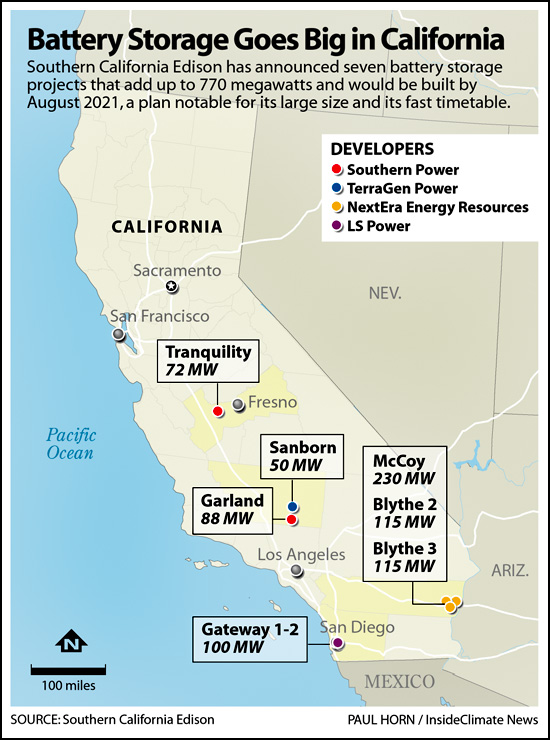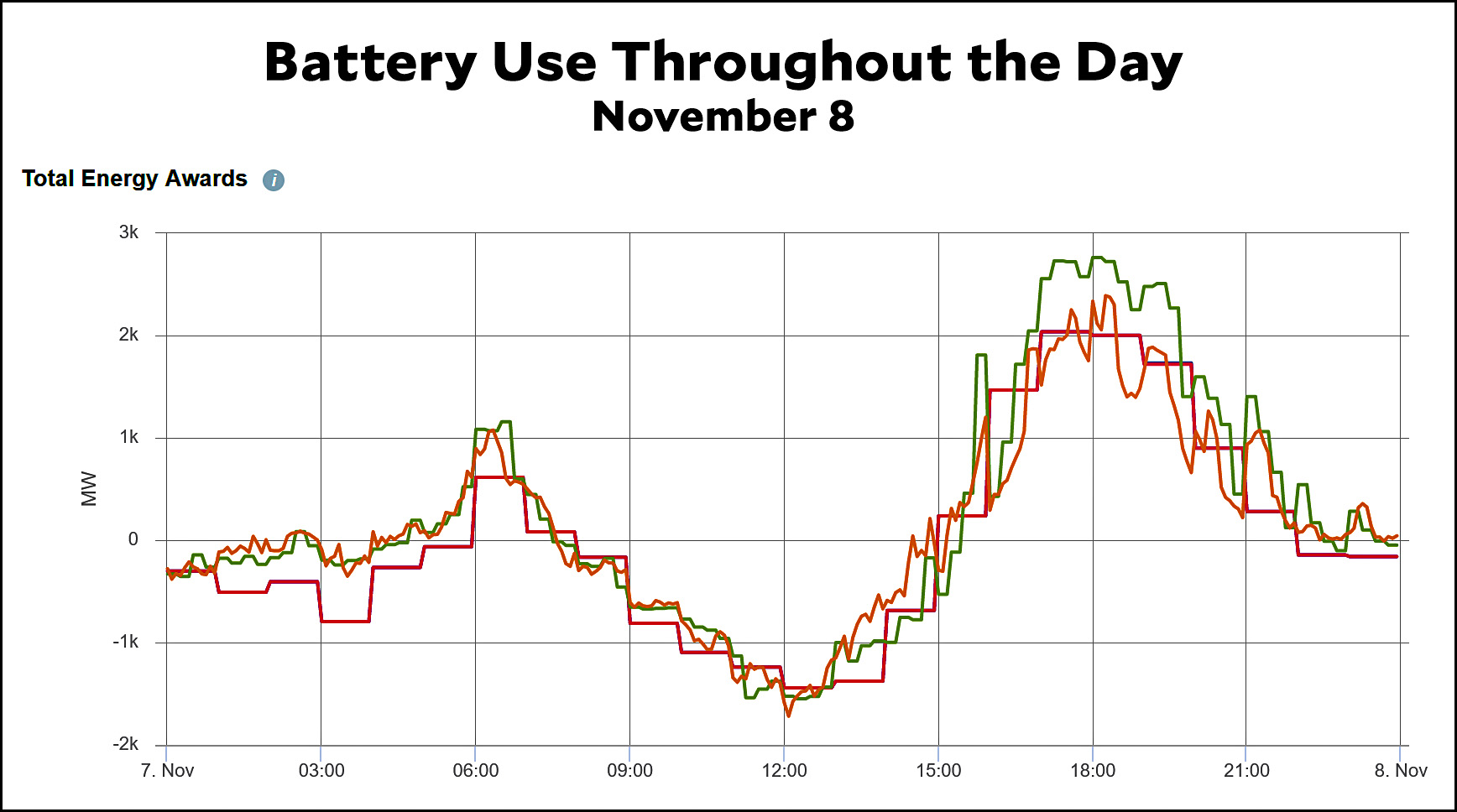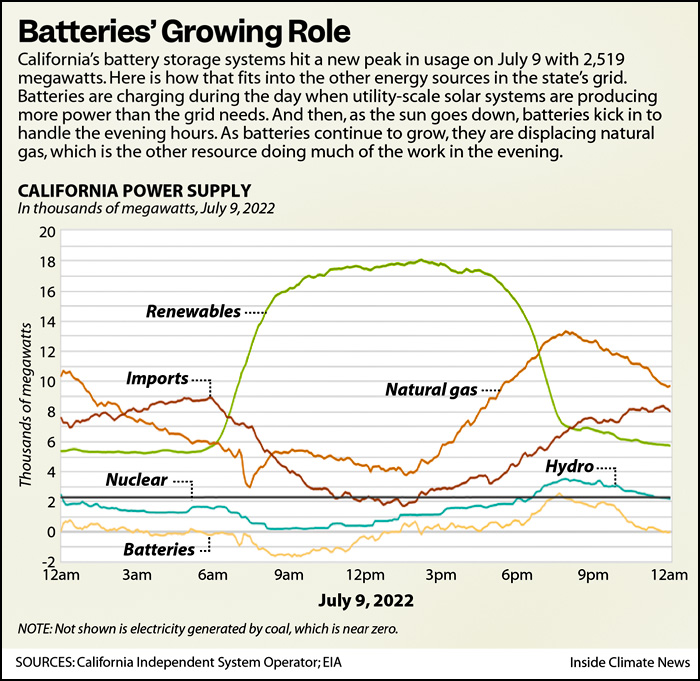Last night, as we were watching the election returns, I was given a homework assignment: How many utility-scale solar plants in California are built with battery storage so they can provide power after the sun goes down?
The short answer is that 58% of new solar projects were paired with battery storage in 2021. The long answer is a little more interesting. For starters, here is the power outlook for today, November 9, 2022:
 Next up, here's a map of some recent solar/battery hybrids that were brought online in 2021:
Next up, here's a map of some recent solar/battery hybrids that were brought online in 2021:
 But the interesting part is that while it makes sense to co-locate solar and batteries, there's no real reason to. You can just build a standalone battery farm and connect it to the grid. So the critical metric isn't 58%, it's the raw capacity to supply power to the grid regardless of where it comes from. Here it is:
But the interesting part is that while it makes sense to co-locate solar and batteries, there's no real reason to. You can just build a standalone battery farm and connect it to the grid. So the critical metric isn't 58%, it's the raw capacity to supply power to the grid regardless of where it comes from. Here it is:
 This number has skyrocketed over the past couple of years and continues to rise. In mid-2021 batteries provided 1,420 megawatts of power to the grid. Today it's over 2,000. Here is yesterday's battery usage throughout the day:
This number has skyrocketed over the past couple of years and continues to rise. In mid-2021 batteries provided 1,420 megawatts of power to the grid. Today it's over 2,000. Here is yesterday's battery usage throughout the day:
 Finally, here's a chart that ties it all together:
Finally, here's a chart that ties it all together:
 This is a little complicated, but it shows the sources of California electricity throughout the day. During daylight hours, solar and wind ("renewables") provide about 18,000 megawatts of power, far more than any other source. From dawn to midafternoon excess solar power is stored in the battery network. When it gets dark, the wind keeps blowing but we lose 12,000 megawatts of solar power. This is currently replaced by 8,000 megawatts of natural gas, 5,000 megawatts of imports from other states, and 2,000 megawatts of battery storage in order to meet peak demand during the hours of 7pm-10pm. Meanwhile, nuclear baseload chugs along at a constant 2,000 megawatts all day.
This is a little complicated, but it shows the sources of California electricity throughout the day. During daylight hours, solar and wind ("renewables") provide about 18,000 megawatts of power, far more than any other source. From dawn to midafternoon excess solar power is stored in the battery network. When it gets dark, the wind keeps blowing but we lose 12,000 megawatts of solar power. This is currently replaced by 8,000 megawatts of natural gas, 5,000 megawatts of imports from other states, and 2,000 megawatts of battery storage in order to meet peak demand during the hours of 7pm-10pm. Meanwhile, nuclear baseload chugs along at a constant 2,000 megawatts all day.
Today, battery storage provides about 7% of peak demand, but the plan is to keep building massive battery capacity so we can reduce the use of natural gas plants during the evening.
NOTE: California is by far the biggest user of battery storage in the country. It has about twice the capacity of the #2 state, Texas, and five times as much as #3, Illinois.

I have 16.48kw of solar (48 panels) and 3 Tesla powerwalls (with a capacity of 40kwh).
If we can build batteries fast enough, this is the solution in a sunny state like CA.
You don't really grasp, until you have panel on your roof, how much power there is from the Sun and how existing technology allows you to just take it. You don't really grasp, until you have battery back up, how existing technology allows you to run a house, and in our case, two EVs, off of the sun.
The catch isn't battery technology or solar panel tech, the catch is the grid needs to be maintained and the grid has historically been paid for via charges per kwh used.
I'll cut to the chase, we can accomplish substantial cuts in emissions, convert to EVs, no problem. But we will need to pay for the grid like roads.
Its not that radical but it should happen. If it does, decentralized solar and battery storage can further accelerate the green switch over.
As someone looking to put panels on their roof , roughly how much did those panels and batteries put you back?
Good question. The answer is in two parts.
The easy part is cost. My system was $54K before tax incentives, which are now as good or better.
But the harder part is that you have to do more math to figure out the actual cost. By "actual cost" I mean you can look at your bill and see what your utility charges you per kwh. In my case its LADWP and its a blended rate of about 20 cents.
You have to (a) figure out how many panels will fit on your roof, and then (b) based on roof angle and shade and orientation what they will produce in a year. A free site called PV Watts has a calculator.
The batteries do not add to production but basically adding battery back up has three benefits (1) actual back up, which of course is more or less valuable depending upon how often the grid goes down for you, (2) "green" cred - depending on how many batteries you get, it will make it through some of the night or all of the night (I sometimes go weeks without pulling power from the grid), and you can say as Kevin pointed out "I don't pull any power at peak hours (when there is the most pollution), and the third benefit (3) depending on your utility, they may charge such a differential for peak electricity, the batteries, which allow you to use your own solar energy as opposed to getting a partial credit and then paying through the nose, actually do provide an economic benefit.
In my case, the system costs about 16 cents per kwh over 20 years (I suggest using 20 years as that is the warranty of the system -- i.e., once you figure out your annual production, you multiply it by 20 and then divide the total cost by that number.
Solar alone would have cost about 11 cents per kwh.
Anyway, its a long answer but that's the answer.
Tack.
Nice work, Kevin! Worthy of any energy blogger. Greatly appreciated.
Why did you install so much battery storage? Was it for the convenience of not having to change your lifestyle (avoiding having to charge the EVs and using most appliances at night)?
Unfortunately "the authorities" seem to have the same attitude to personal batteries that they used to have to solar, dragging their feet and raising BS objections whenever they can apparently purely on the grounds of "anything new is scary and dangerous".
I tried three years ago to get a Powerwall attached to my solar and local officials (city owns local electricity generation) refused. Tried a year later, same story. Weird claims that make no sense to me, like it's dangerous to have such a large battery inside a residence.
I guess I should try again and see if, THIS TIME, they are more reasonable...
Kevin, while the MW or GW of the battery is of interest,there is still the matter of *Wh to consider. Particularly when you get several cloudy days in a row, such as we just experienced here in California.
If we get several cloudy days in a row then that is not a heat wave. Air conditioning load will be low and the grid won't be stressed.
And in the winter when we no longer should/may use natural gas for heating (or hot water)?
The trend toward electric heating is barely getting started and not yet showing up in utility loading. Ask again in 10 years, by which time there will be a lot more wind, solar, and batteries.
Not my favored source but still:
How does your chart account for when batteries are charging, presumably during daylight hours? Are they like any other consumer? Or are they subtracted from solar/wind output?
Peter, if you look closely at the battery graph at the bottom of Kevin's somewhat complicated graph, you'll notice that during the mid-day hours they are net negative contributors. That's when they are drawing power from the total produced (mainly by renewables at that part of the day) to recharge.
In essence, you can think of watt-hours as a fungible item for the purpose of looking at the chart.
Business Insider recently ran a story on vehicle-to-grid, which permits the use of EVs as grid storage. Given the total storage capacity that is going into EVs, and the amount of time that most of them are going to spend unused, this seems like a very sensible solution.
It looks like the typical non-commercial EV these days has about 70 kwh of storage. A million such vehicles, which is a tiny fraction of all the vehicles in California, would provide 70 gwh of storage, which would be enough to replace all of California's electrical generation for more than 3 hours. Universal vehicle to grid, with vehicles charging when there is surplus electricity and feeding back into the grid when there is a shortage, has the potential to meet all storage requirements with lots of spare capacity.
Naturally, there are lots of details to work out. There would be some kind of floor, presumably adjustable by each vehicle owner, to have the vehicle stop feeding the grid when state of charge falls below the floor. (If you're a short distance commuter, you can accept starting your day with 50% charge; if you have a longer drive in prospect, you may want to be sure you have at least 80%). The matter of payment to the vehicle owners would also have to be addressed, and no doubt all sorts of other things would need to be looked at
Vehicle to Grid is great in the sense that a battery pack in, say, my Telsa Model 3 is 75 kwh which is more than enough to get my own house through a night, probably could get like three houses through peak period and still leave 50% charge.
Anyway, the issue, I would not say "problem" is timing. So you have to charge up those car batteries. If its Powerwalls on the side of the house, you charge them during the day from the excess sun.
Most people use their EVs in the opposite of VTG, charge at night, drive them (discharge) during the day.
To make VTG work statewide, you would have to expand day time charging when cars are parked and people are at work, as that is when the solar is pumping.
That is not really set up at the moment.
Now, mass VTG could easily handle those one and two hour shut offs that are now common, that would be no problem.
As I said, lots of details. One of those details is that if you're in a region with lots of solar power, businesses need to be encouraged to wire their parking lots so employee vehicles can charge during the day when there's a lot of surplus power. This has been noted by planners.
Battery packs can be put anywhere on the grid...but best set up as part of microgrids to keep from stressing transmission lines and triggering fires.
When discussing batteries or other energy storage methods, it is better to use energy (Mw-hr) rather than power (Mw). Conventional power plants are rated in Mw because it is assumed between major overhauls they can operate 24-7 (or close to it) at their rated power. A battery in contrast, can last a long time supplying a low power level but only a short time when supplying a high power level.
Great point for someone reading this without having already gone down the rabbit hole.
Kevin's charts use both numbers. Getting numbers from CAISO always show MW because in the context of answering the question "where is our power coming from at the moment" so many MW total, broken up into MW per source makes sense.
The utility level battery storage is measured in both MW (as in, how much power could these batteries throw off) and MWH, which is what is the capacity of the battery pack?
So I have a 16.48Kw system, which means that is the maximum the panels can produce at a given moment (in reality, my daily production is between 50kwh in the winter and 120kwh in the summer).
I have 40kwh (kilowatt hours) of battery back up, which measures its capacity. The three Powerwalls can also discharge 7kw each, or up to a spike of 21kw, but my house has never come near that even with everything turned on. If they were blasting away at 21kw they would last for two hours.
Last night there was a power outage. At the time, the house was drawing about a kw. So, the battery was saying "40 hours left" - when the electric heater for the spa went on, and spiked home usage up to 6kw, the battery app said "6 hours left" which would have been six hours times 6kw.
Its complicated. But ultimately interesting and understandable.
When it switches to the Powerwall is there a chime or flicker or other indication?
Another user of solar panels + battery backup here, although my system is smaller than Yikes's is. We have a small household, and one 14 kWh PowerWall easily powers us through the night, while the solar panels provide energy during the day. When the power goes out, we still have juice and don't even notice the outage until our neighbors knock on the door. It's great. PG&E and Tesla recently ran a pilot program, asking us and other PowerWall owners if they could tap into our stored energy when demand is high, paying us $2/kWh to do so. They tapped into our battery during the big heat wave we had a few months ago. Not sure how much a difference it made, but it was nice to think we could contribute to stabilizing the grid.
https://www.theguardian.com/world/2022/nov/09/france-to-require-all-large-car-parks-to-be-covered-by-solar-panels
This is the other part needed for VTG (vehicle-to-grid). The cars charge while their owners are at work, so that when they get home they're ready to power the grid when the sun isn't shining. (Added perk: a shaded parking place!)
I never really got this. Lithium batteries are expensive, depend on foreign sources of materials, and tend to get all splody without warning. To me, it makes more sense to send power to the coast, use it to split water into hydrogen and oxygen, store the hydrogen and vent the oxygen, and at night burn the hydrogen to make water and power. You don't even need a fuel cell. This little bit of high school chemistry is so blindingly obvious that I'm pretty sure there is a good reason I'm unaware of to explain why no one does it. Perhaps it has efficiency issues.
It has efficiency issues. At best, a fuel cell is about 65% efficient. The best combustion engines are about 40% efficient.
One of the things I never see addressed is whether lithium batteries are the best battery chemistry for stationary storage. They're useful in mobile applications, from cell phones to semi-trailer trucks, because of their high energy density. However, in stationary applications energy density doesn't matter. If the battery never moves, it doesn't matter how much it weighs. What counts is cost, life expectancy, and reliability. Old fashioned lead acid batteries, for instance, are much cheaper and much heavier than lithium batteries for the same storage capacity, but appear to have a considerably shorter life expectancy, which may offset "cheaper".
I'm going to assume that competent engineers have looked at this, but their work doesn't seem to get popular press coverage.
Lead acid is problematic for various reasons, but as you said, lithium is primarily about weight.
There are serious investigations into lithium-like batteries that instead use sodium (much more plentiful) and that work will, in time, hopefully result in substantially cheaper batteries for this sort of stationary storage. It's not yet clear that there are INTRINSIC problems with sodium; it's more just that around 30 years ago it made more sense to solve each problem with lithium because the lithium weight issue was so valuable for the primary battery use cases at the time (electronics, then cars).
At least right now, it seems like the same level of effort (optimize each component, figure out the reason for various limitations and work around them) that got us lithium will get us sodium, and probably faster given that we have the lithium experience.
If collocated then they can share the (large) grid connection.